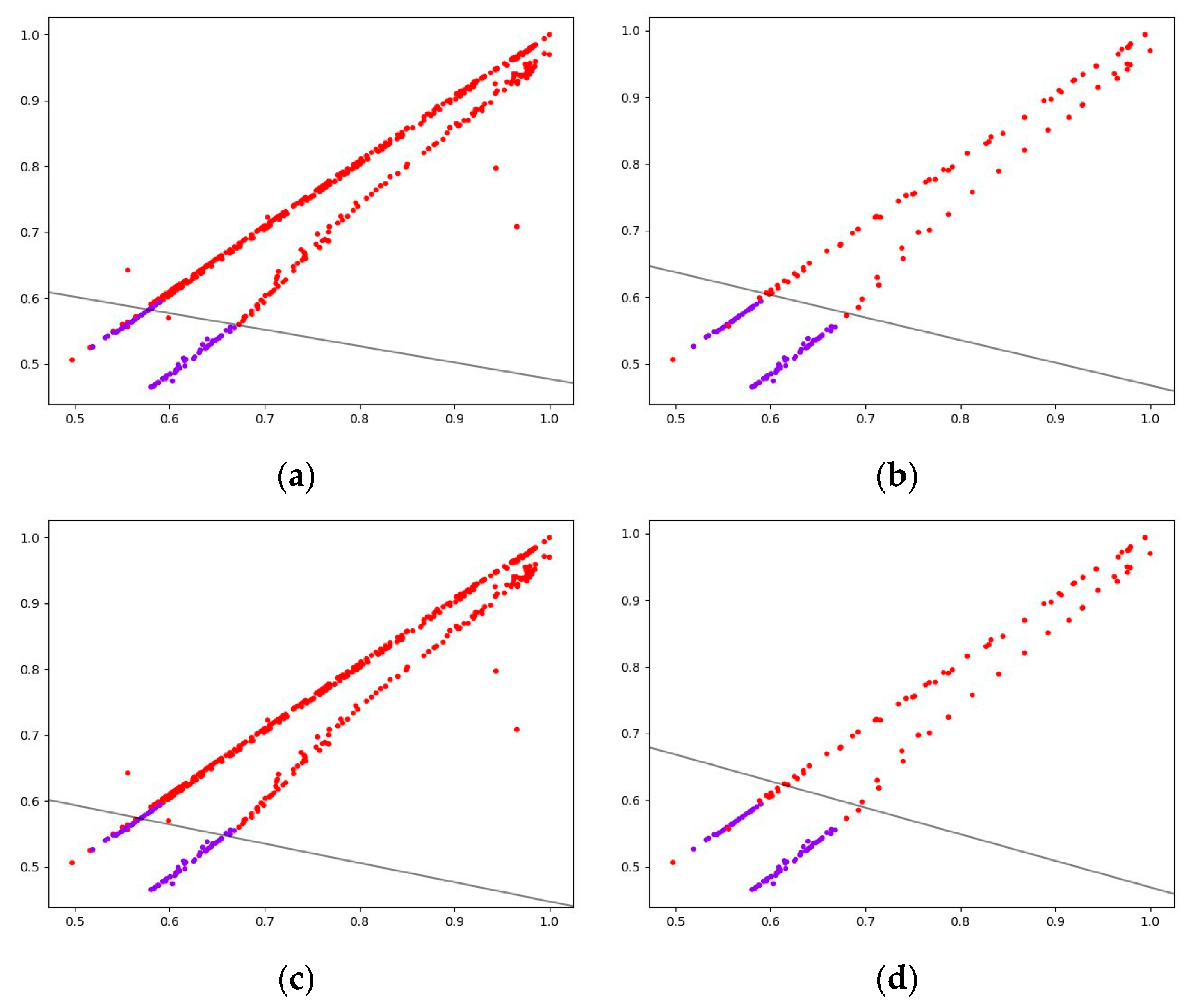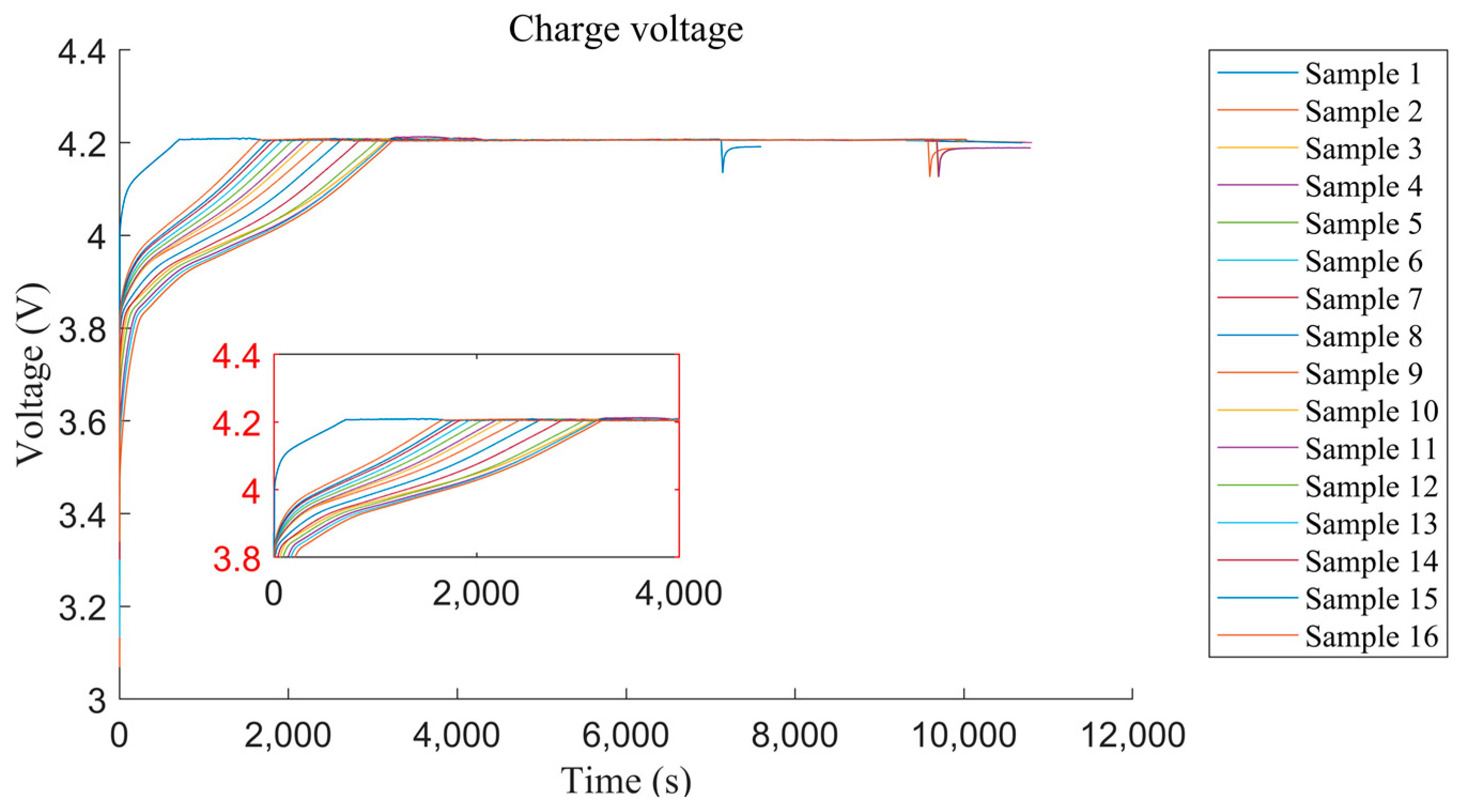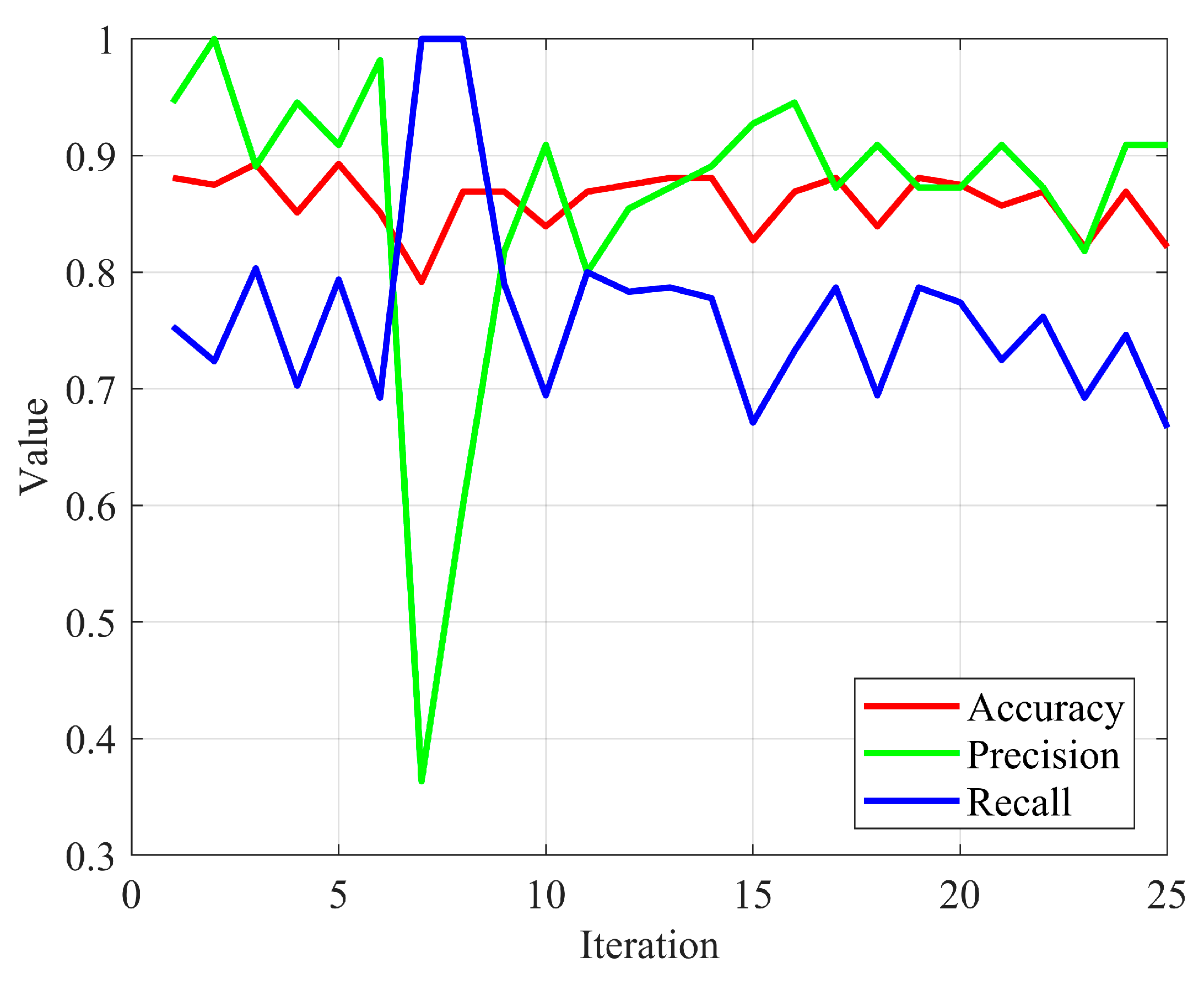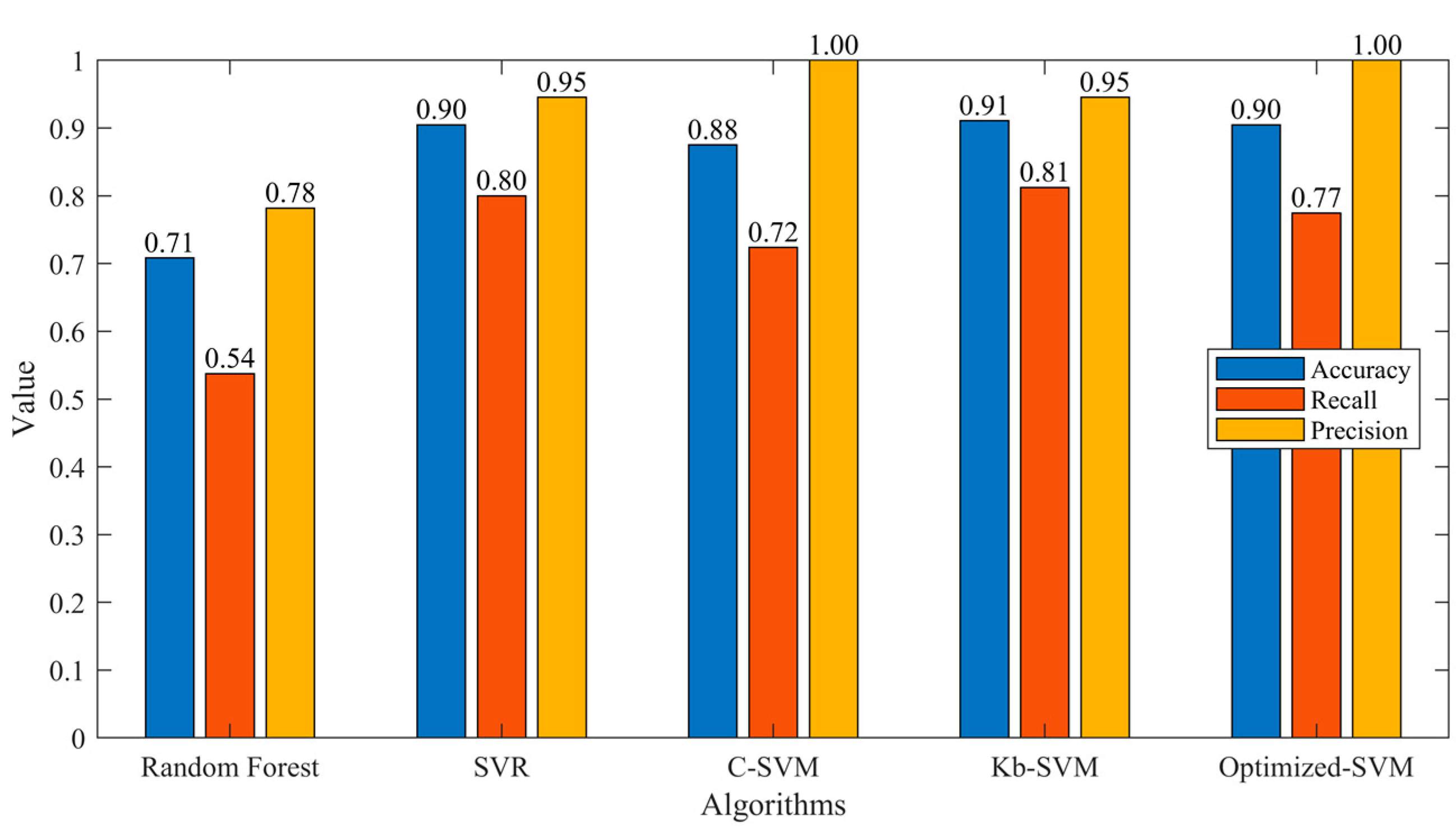Airborne Lithium Battery Health Assessment: An Improved Support Vector Machine Algorithm for Imbalanced Sample Sets
Abstract
1. Introduction
2. Experimental Methods
2.1. Analysis of Unbalanced Sample Set Based on SVM
2.2. Improved SVM Algorithm for Unbalanced Samples
2.2.1. Penalty Parameter Grading Based on Geometric Distance
2.2.2. Analysis of Hyperplane Migration Suppression Ability
2.2.3. Decision Function Adjustment for Enhanced Fault Sample Identification
2.2.4. Flow of Improved SVM Optimization Algorithm
3. Results
3.1. Data Preprocessing
3.2. Iteration Process of Optimized SVM
3.3. Accuracy of the Prediction by Optimized SVM
3.4. Comparision of the Performance with Other Baseline Methods
4. Discussions
5. Conclusions
Author Contributions
Funding
Data Availability Statement
Conflicts of Interest
References
- Liu, Z.Y. Research on Aircraft Battery Test Technology; Nanjing University of Aeronautics and Astronautics: Nanjing, China, 2015. [Google Scholar]
- Xie, S.; Gong, Y.Z.; Li, M.H. Progress in the application of lithium-ion batteries in the field of civil aviation. Batteries 2020, 50, 388–392. [Google Scholar] [CrossRef]
- ANON. Aircraft Incident Report: Auxiliary Power Unit Battery Fire Japan Airlines Boeing 787-8, JA829J, Boston, Massachusetts, January 7, 2013; National Transportation Safety Board: Washington, DC, USA, 2014. [Google Scholar]
- Chen, M.; Wu, J.; Jiao, C.Y.; Chen, J.Z.; Zhang, Z.P. Multi-factor online estimation method of lithium-ion battery health status. J. Xi’an Jiaotong Univ. 2020, 54, 169–175. [Google Scholar]
- Ovejas, V.J.; Cuadras, A.; Morante, J.R. SoH evaluation of LiFePO4 cells using impedance and thermal measurements. In Proceedings of the 2014 IEEE 11th International Multi-Conference on Systems, Signals & Devices (SSD14), Barcelona, Spain, 11–14 February 2014; pp. 1–6. [Google Scholar]
- Sarikurt, T.; Ceylan, M.; Balikci, A. An analytical battery state of health estimation method. In Proceedings of the 2014 IEEE 23rd International Symposium on Industrial Electronics (ISIE), Istanbul, Turkey, 1–4 June 2014; pp. 1605–1609. [Google Scholar]
- Shi, W.J.; Wang, H.M. Research on SOH online diagnosis model based on thermal characteristics of lithium-ion battery. Chin. J. Sci. Instrum. 2020, 41, 206–216. [Google Scholar]
- Zhou, D.; Song, X.H.; Lu, W.B.; Fu, P. Real-time SOH Estimation Algorithm for Lithium-ion Batteries Based on Daily Segment Charging Data. Proc. Chin. Soc. Electr. Eng. 2019, 39, 105–111. [Google Scholar] [CrossRef]
- Pan, C.F.; Liu, B.; Chen, L.; He, Z.; Han, C. Temperature rise characteristic analysis and liquid cooling structure design of lithium battery. J. Southwest Jiaotong Univ. 2020, 55, 68–75. [Google Scholar]
- Yang, Y.L.; Chen, S.Y.; Chen, T.; Huang, L. State of health assessment of lithium-ion batteries based on deep Gaussian process regression considering heterogeneous features. J. Energy Storage 2023, 61, 106797. [Google Scholar] [CrossRef]
- Yang, S.J.; Zhang, C.P.; Jiang, J.C.; Zhang, W.; Zhang, L.; Wang, Y. Review on state-of-health of lithium-ion batteries: Characterizations, estimations and applications. J. Clean. Prod. 2021, 314, 128015. [Google Scholar] [CrossRef]
- Wu, L.X.; Liu, K.; Pang, H.; Jin, J. Online soc estimation based on simplified electrochemical model for lithium-ion batteries considering current bias. Energies 2021, 14, 5265. [Google Scholar] [CrossRef]
- Geng, Z.Y.; Wang, S.Y.; Matthew, J.L.; Brandell, D.; Thiringer, T. Bridging physics-based and equivalent circuit models for lithium-ion batteries. Electrochim. Acta 2021, 372, 137829. [Google Scholar] [CrossRef]
- Liu, W.; Yang, G.; Meng, D.; Li, L.; Wang, B. Modeling method of lithium-ion battery considering commonly used constant current conditions. Trans. China Electrotech. Soc. 2021, 36, 5186–5200. [Google Scholar]
- Zhang, K.; Yin, J.X.; He, Y.Z. Acoustic emission detection and analysis method for health status of lithium-ion batteries. Sensors 2021, 21, 712. [Google Scholar] [CrossRef] [PubMed]
- Yin, Z.; Hou, J. Recent advances on SVM based fault diagnosis and process monitoring in complicated industrial processes. Neurocomputing 2016, 174, 643–650. [Google Scholar] [CrossRef]
- Cui, J.; Yan, X.; Pu, X.; Qi, Y.; Jiang, L.; Shi, J. Aero-engine fault diagnosis based on dynamic PCA and improved SVM. Zhendong Ceshi Yu Zhenduan/J. Vib. Meas. Diagn. 2015, 35, 94–99. [Google Scholar] [CrossRef]
- Ge, X.K.; Hu, J.B.; Xu, B. Status data analysis of inertial navigation and construction of fault diagnosis model based on SVM. Syst. Eng. Theory Pract. 2012, 32, 405–410. [Google Scholar]
- Zhou, D.; Zhuang, X.; Zuo, H.; Cai, J.; Bao, H. Hazard identification and prediction system for aircraft electrical system based on SRA and SVM. Proc. Inst. Mech. Eng. Part G J. Aerosp. Eng. 2020, 234, 1014–1026. [Google Scholar] [CrossRef]
- Zhou, D.; Zhuang, X.; Zuo, H.; Wang, H.; Yan, H. Deep Learning-Based Approach for Civil Aircraft Hazard Identification and Prediction. IEEE Access 2020, 8, 103665–103683. [Google Scholar] [CrossRef]
- Vapnik, V.N. An overview of statistical learning theory. IEEE Trans. Neural Netw. 1999, 10, 988–999. [Google Scholar] [CrossRef] [PubMed]
- Li, H. Statistical Learning Methods; Tsinghua University Press: Beijing, China, 2019. [Google Scholar]
- Gao, D. Prediction of the Remaining Life of Lithium-Ion Batteries Based on New Health Indicators; Wuhan University of Technology: Wuhan, China, 2018. [Google Scholar]
- Saha, B.; Goebel, K. Battery Data Set, NASA Prognostics Data Repository; NASA Ames Research Center: Mountain View, CA, USA, 2007. [Google Scholar]
- Zhang, Z.; Li, Y.; Li, Y.; Liang, X. Research on SOC estimation of lithium batteries using several machine learning algorithms. J. Chongqing Univ. Technol. (Nat. Sci.) 2023, 37, 40–48. [Google Scholar]
- Han, W.; Wang, S.; Zhang, X.; Li, Y.; Chen, W. Holistic comparison of different kernel functions for support vector regression based on state-of-health prediction of lithium-ion battery. Chin. J. Power Sources 2021, 45, 362–365, 377. [Google Scholar] [CrossRef]
- Huang, Y.; Wang, T.; Pei, H.; Wang, J.; Wang, X. Diagnosis method of diesel common rail system based on operating conditions and multi-category support vector machine. Trans. Beijing Inst. Technol. 2023, 43, 719–725. [Google Scholar]
- Zhang, R.; Liu, T.Y.; Jin, G. Remaining useful life prediction of lithium-ion batteries based on Gaussian process regression with self-constructed kernel. Syst. Eng. Electron. 2023, 45, 2623–2633. [Google Scholar]







| Parameter Name | Parameter Value |
|---|---|
| Battery Model | 18,500 |
| Maximum Charge Cut-off Voltage | 4.2 V |
| Rated Voltage | 3.6 V |
| Rated Capacity | 2 Ah |
| Charging Temperature Range | 0~45 °C |
| Discharge Temperature Range | −20~60 °C |
| Specific Magnetization | −20~60 °C |
| Algorithms | Accuracy (%) | Recall (%) | Precision (%) | Error (%) | Time (s) |
|---|---|---|---|---|---|
| Random Forest [25] | 70.83 | 53.75 | 78.18 | 29.17 | 0.462 |
| SVR [26] | 90.48 | 80.00 | 94.54 | 9.52 | 0.208 |
| C-SVM [27] | 87.50 | 72.37 | 100.00 | 12.50 | 1.034 |
| Kb-SVM [28] | 91.07 | 81.25 | 94.54 | 8.93 | 0.251 |
| Optimized-SVM | 90.48 | 77.47 | 100.00 | 9.52 | 0.529 |
Disclaimer/Publisher’s Note: The statements, opinions and data contained in all publications are solely those of the individual author(s) and contributor(s) and not of MDPI and/or the editor(s). MDPI and/or the editor(s) disclaim responsibility for any injury to people or property resulting from any ideas, methods, instructions or products referred to in the content. |
© 2024 by the authors. Licensee MDPI, Basel, Switzerland. This article is an open access article distributed under the terms and conditions of the Creative Commons Attribution (CC BY) license (https://creativecommons.org/licenses/by/4.0/).
Share and Cite
Yang, C.; Ge, H.; Jin, H.; Liu, S. Airborne Lithium Battery Health Assessment: An Improved Support Vector Machine Algorithm for Imbalanced Sample Sets. Aerospace 2024, 11, 467. https://doi.org/10.3390/aerospace11060467
Yang C, Ge H, Jin H, Liu S. Airborne Lithium Battery Health Assessment: An Improved Support Vector Machine Algorithm for Imbalanced Sample Sets. Aerospace. 2024; 11(6):467. https://doi.org/10.3390/aerospace11060467
Chicago/Turabian StyleYang, Chunxia, Hongjuan Ge, Hui Jin, and Shengjun Liu. 2024. "Airborne Lithium Battery Health Assessment: An Improved Support Vector Machine Algorithm for Imbalanced Sample Sets" Aerospace 11, no. 6: 467. https://doi.org/10.3390/aerospace11060467
APA StyleYang, C., Ge, H., Jin, H., & Liu, S. (2024). Airborne Lithium Battery Health Assessment: An Improved Support Vector Machine Algorithm for Imbalanced Sample Sets. Aerospace, 11(6), 467. https://doi.org/10.3390/aerospace11060467





